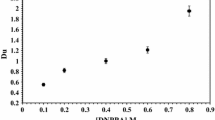Abstract
Dihydroxyurea (DHU) was synthesized using tri-associated solid phosgene [bis(trichloromethyl) carbonate] dissolved in dioxane and hydroxylamine hydrochloride dissolved in potassium acetate solution. The reduction of Pu(IV) by DHU was investigated using UV-Vis spectrophotometry. The reduction back-extraction behavior of Pu(IV) in 30% tri-butyl phosphate/kerosene was firstly investigated under conditions of various temperature, various DHU and HNO3 concentrations and various phase contact times. The results showed that Pu(IV) in the organic phase can be stripped rapidly to the aqueous phase by DHU. Simulating the 1B contactor of the PUREX process using a 0.1 M DHU in 0.36M nitric acid solution as the stripping agent, the separation factors of uranium/plutonium can reach 2.1·104. This indicates that DHU is a promising salt free agent for uranium/plutonium separation.
Similar content being viewed by others
References
I. S. Denniss, A. P. Jeapes, The Nuclear Fuel Cycle, Oxford Science Publications, Oxford, 1996, p. 156.
J. H. Miles, Separation of plutonium and uranium. Science and technology of tributyl phosphate, in: Application of Tributyl Phosphate in Nuclear Fuel Reprocessing, Vol. 3, CRC Press Inc., Florida, 1990.
V. S. Koltunov, V. I. Marchenko, Stabilization of Pu and Np Valences in Purex Process: Problems and Outlook. in: Proc. 5th Intern. Nuclear Conference on Recycling, Conditioning and Disposal[C], Nice France, The French Nuclear Society and the European Nuclear Society, 1998, p. 425.
V. S. Koltunov, S. M. Baranov, Radiokhimiya, 35(6) (1993) 11.
Ye Guoan, Chinese At. Energy Sci. Technol., 38(2) (2004) 152.
V. S. Koltunov, S. M. Baranov, Eh. A. Mezhov et al., Acetaldoxime: A promising reducing agent for Pu and Np ions in the PUREX Process, International Conference Scientific Research on the Back-end of the Fuel Cycle for the 21 Century, Atalante 2000, Avignon (France), 24–26 Oct 2000, 01–06.
J. H. Miles, Stabilisation of an Element Against Oxidation [P], U.K. Patent: 2216886, 1989.10.
Zhu Zhaowu, He Jianyu, Zhang Zefu et al., J. Radioanal. Nucl. Chem., 262 (2004) 707.
E. Boyland, R. Nery, J. Chem. Soc. (C), (1966) 350.
E. Boyland, R. Nery, Nature, 26(4952) (1964) 1379.
R. Nery, Analyst, 91 (1966) 338.
Jiang Shengjie, Ren Fengyi, Nuclear Fuel Reprocessing, Atomic Energy Press, 1995, p. 429.
Lin Zhangji, Tan Bingmei, J. Nucl. Radiochem., 12(2) (1990) 85.
K. Cornelius, The Chemistry of the Transuranium Elements, Verlag Chemie Gmbh, 1971, p. 428.
R. J. Taylor, I. May, A. L. Wallwok et al., J. Alloys Compd., 271–273 (1998) 534.
Ren Fengyi, Zhou Zhenxing, Foreign Nuclear Fuel Reprocessing, Beijing Atomic Energy Press, 2006, p. 117.
Author information
Authors and Affiliations
Corresponding author
Rights and permissions
About this article
Cite this article
Taihong, Y., Weifang, Z., Guoan, Y. et al. Synthesis of dihydroxyurea and its application to the U/Pu split in the PUREX process. J Radioanal Nucl Chem 279, 293–299 (2009). https://doi.org/10.1007/s10967-007-7289-1
Received:
Published:
Issue Date:
DOI: https://doi.org/10.1007/s10967-007-7289-1




